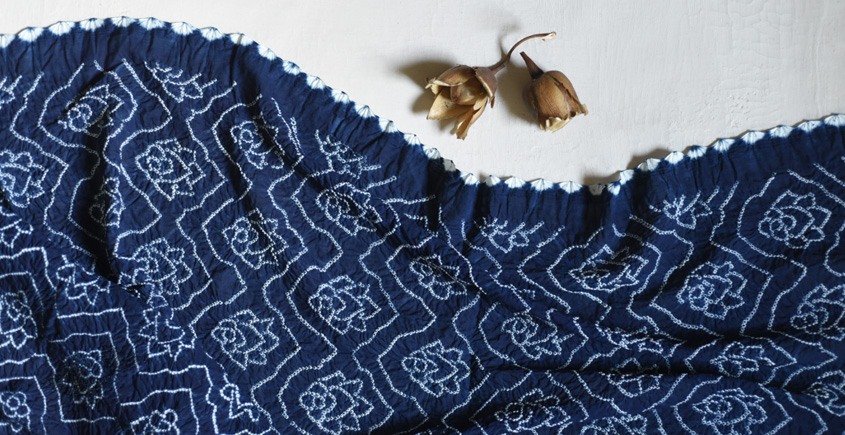Bandhani Art

The Bandhani Craft’s History
One of India’s oldest and most beautiful textile art forms, bandhani is characterized by its bright colors produced by the tying and dying of fabric. “Bandhani” literally comes from the Sanskrit word “Bandh,” which simply means “to tie.” The earliest signs of this ancient style of art are over 5000 years old, from the Indus Valley Civilization. It has a historic past and has been practiced for numerous generations in the states of Gujarat as well as Rajasthan. Individuals adorning Bandhani fabrics, mostly during religious times and celebrations, are also described in ancient literary works and portraits. Bandhani, which often relates to nobility, rituals, and celebration, became a major part of western India’s social and cultural life.
Bandhani’s Significance in Indian Culture
Bandhani is not only a fabric art form; it is an expression of happiness, culture, and tradition. Bandhani is employed in religious rituals, weddings, and festivals such as Navratri in Gujarat and Rajasthan. For example, Rajasthani women often wear sarees or Bandhani odhnis for their weddings. In Bandhani, the motifs and colors also often carry symbolic significance: blue is often linked to Lord Krishna, yellow with new beginnings, and red to marriage and felicity. Further, Bandhani is also perceived as a reflection of prosperity and good fortune. Apart from the beauty it exhibits, it even represents the honor and identity of the local population, especially the women artisans who pass on this art form through generations.
How to Make Bandhani
Bandhani-making is a labor-intensive and artistic process. It starts with a piece of cloth, usually silk or cotton, which is folded and tightly knotted at small points with thread. Fingernails or equipment are utilized to tie these miniature knots in a certain way. The pattern is created by each knot, which prevents the dye from reaching that part of the fabric. Depending on the number of colors, the cloth can be dipped in color once or multiple times after being tied. With re-tying and drying in between, the cloth is colored from light to dark shades to produce multicolored Bandhani. The final design is revealed by gently opening the knots after coloring is complete. The last pattern is achieved by gently opening the knots once the coloring is complete. The effect is a beautiful, dotted pattern that can be as simple or as complex as one wishes. Another term for this technique is “tie and dye.”
Bandhani Types and Materials Used
Light, airy materials and natural or chemical dyes are employed in making bandhani. Muslin, georgette, cotton, and silk are the most commonly used materials. Silk Bandhani is mostly employed for occasions, while cotton is great for everyday wear. Depending on the craftsman and market, the dyes employed can be chemical (derived from chemicals) or natural (obtained from plants and minerals).
The following are the major tools employed to create bandhani:
- Thread: Cotton thread is normally used for securing the knots tightly.
- Wooden tools or needles are sometimes utilized to assist in accurate tying.
- Fabric containers used to dip the fabric in numerous colors are referred to as dye tubs.
- Bandhani patterns exist in many different shapes, each with its own name and look:
- Ek Dali and Trikunti are simple one- or three-dot designs.
- Boond: A small, dark-centered dot that looks like a drop of water.
- Laddu Jalebi: Sweet-looking round designs.
- Leheriya: A well-known pattern in Rajasthan that looks like waves and is created using diagonal lines.
- Shikari Bandhani: More complex and detailed patterns, like flowers, birds, or animals.
- Gujarati brides often adorn gharchola, which is a blend of bandhani and zari (gold thread).
Bandhani from every place has a different taste. For example, Sikar and Jaipur in Rajasthan and Jamnagar and Bhuj in Gujarat are renowned for their unique Bandhani prints. While some places focus on intricate designs, others use bolder colors.
In summary, Bandhani’s ageless appeal
Bandhani is a story of tradition, grit, and creativity more than a craft. Bandhani’s colors and beautiful designs have captivated individuals since the ancient era and into modern fashion. It represents the essence of Indian culture, especially in the western regions. Bandhani is creating a new market in India and internationally as the world transitions to sustainable and handmade fashion. Bandhani is now being utilized by fashion designers in modern ensembles like dresses, dupattas, kurtas, and even accessories. The human touch, though, is what truly makes Bandhani stand out; every knot and pattern is made with love and care by skilled artisans. Not only do we get to wear a masterpiece, but we can help preserve a rich heritage for generations to come by patronizing Bandhani craft.